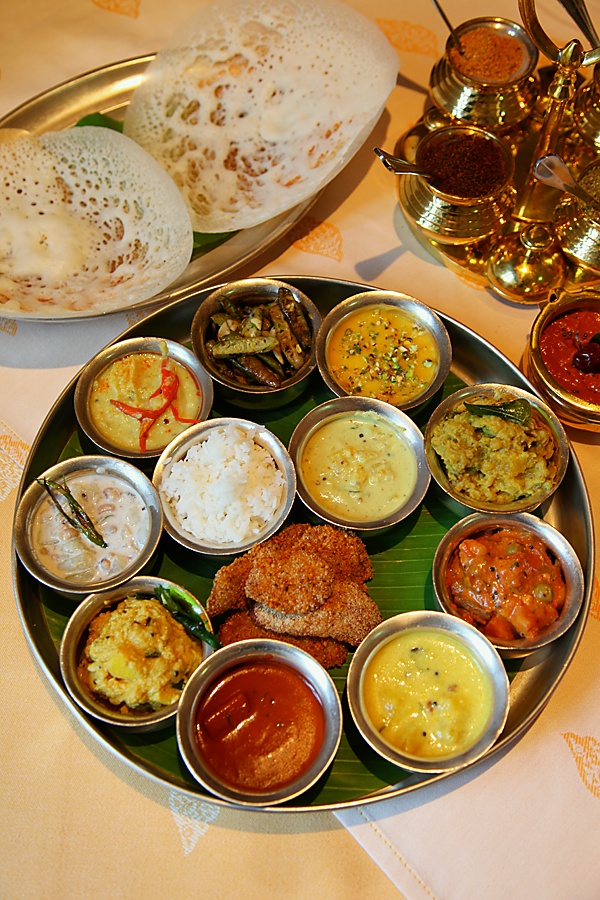
Ayurveda, India’s age old medical science, classifies food into sattvic (goodness), rajasic (passion) and tamasic (ignorance) modes. Foods in the mode of goodness or sattvik foods are said to be without meat, fish, eggs, alcohol, caffeine, onions and garlic.
The use of onions and garlic is especially prevalent in North Indian cooking, which has been heavily influenced by the Moghuls who ruled India between 1526 to 1761. This tradition gradually trickled down south.
But, even today traditional South Indian vegetarian cuisine is probably one of the most prominent foods that hardly uses onions and garlic and even to this day if you visit an orthodox South Indian household you will find many dishes prepared without them (also, if you visit any strict vegetarian Buddhist,Thai, Vietnamese, Chinese or Japanese restaurants around the world, you are most likely to find any members of the allium family missing from the food). The iconic South Indian vegetarian classic cookbook Samaithu Paar or the English version “Cook And Seeâ€, published in the 1950‘s, considered the pioneer of starting the trend of publishing cookbooks in India and still known as a bible for young brides and for those who want to learn the nuances of South Indian vegetarian cuisine has a total of 350 dishes in it. It might surprise you that only 5% of these dishes have onions and garlic in them with the word optional mentioned in the brackets for those recipes which happen to use them. This corroborates the absence of onions and garlic from South Indian vegetarian cuisine.
We as a family, love sattvik meals and on a sunday afternoon, when I was lunching at “Dakshin†at the ITC Maratha, which happens to be a favourite with me and Ro for a long time now, the server brought in a succulent dish “manga curry†(a curry prepared with mangoes in season) specially sent by the chef for me to try, apart from our usual staples of Iyer’s trolley (consisting of a variety of miniature dosas), appam, vegetable stew, ennai kathrikai (a spicy eggplant curry) and biranji (vegetable biriyani). When the chef came in to have a word at the end of our meal, I thought that although I don’t do restaurant reviews here, I must share with you at times, the food I eat outside apart from the dishes that emerge from my kitchen. And also showcase talented chefs who create magic in their kitchens. And I thought what better place to start with than the Dakshin at the ITC Maratha, a hotel which Ro and I have been visiting right from its inception.
Chef Manu Nair, a very enthusiastic and talented young chef from Dakshin restaurant at the ITC Maratha created an exhaustive spread of sattvik South Indian meal specially for DivineTaste consisting of Alvemandi Podi, a spicy savoury dish from the Saraswat community of Karnataka made with colocasia or arbi served with a spicy chili chutney called Korivikaram Chutney from Andhra Pradesh, Kalan, a Keralan dish made with raw bananas and yam and cooked in a mild coconut gravy, Pumpkin Erissery, another exotic traditional Keralan dish, Olan made with black eyed peas and white gourd, something that I really relished, Tindli Bibo Upkari, a Saraswat Brahmin dish from Karnataka made with tendli or ring gourd (known to be a favourite of the cricket maestro Sachin Tendulkar and also a dish which originates from his community), Tarkari Padartha, a vegetable dish in a mildly spiced tomato and cashew gravy, Menaskai, spicy sweet dish from Udupi in Karnataka, Manga Curry, a country style ripe mango and coconut curry, Parippu Kootan, a festive Dal from Kerala and tropical dry fruit payasam, a sweet dish from the temples of Tamil Nadu! Appams, steamed rice, podis or dry chutney powder and the signature Dakshin pappadams completed the menu.
Each and every dish was cooked to perfection and it was also a visual feast for the eyes. The colocasia chips were so delicious that I couldnt stop eating one after the other. The other favourites were olan which was such a simple curry and with hot rice was a great comfort food for me and the kerala style dal. The payasam made with mangoes and garnished with dry fruits was the perfect end to this grand meal.
It was truly a meal fit for a king! The ITC hotels place a lot of emphasis on food in their restaurants and great attention is given to the quality and consistency of food throughout their restaurants across many cities. And that is why you are likely to taste the same chutney or appam at Dakshin in ITC Windsor, Bangalore (known as Windsor Manor way back in the 80's which used to be my childhood favourite) like the Dakshin in Mumbai. Likewise for their famous dal bukhara which is supposed to taste the same at ITC Maurya in Delhi or Chola in Chennai.

Chef Manu who comes from a family of engineers and bankers, faced a lot of opposition from his family but still chose to follow his heart and become a chef! Post the extensive shoot when we were in conversation, Aishwarya from the hotel management pointed out that it is families who carry on the traditions of the many cuisines around the world and in most cases, one family member would have influenced a chef to don the apron and cook up a storm. In Chef Manu’s case, it was his grandmother's exceptional cooking that stirred up the emotions in him to follow his passion and he says that it is she who inspires him to this day.

The cuisine of the 4 South Indian states is so vast with a number of regional variations to each state. Chef Manu has presented these dishes to represent each state. The beauty of these dishes, unlike other hotel menus are that most of them are cooked and eaten at home and have a history and tradition attached to them.

In order to recreate the magic of many of these dishes at home, I’m including the recipes from Chef Manu’s kitchen at the ITC Maratha, Mumbai. You could also reserve a table (+91 28303030) to experience and savour many traditional south Indian delicacies from the menu at the Dakshin, ITC Maratha, Mumbai.
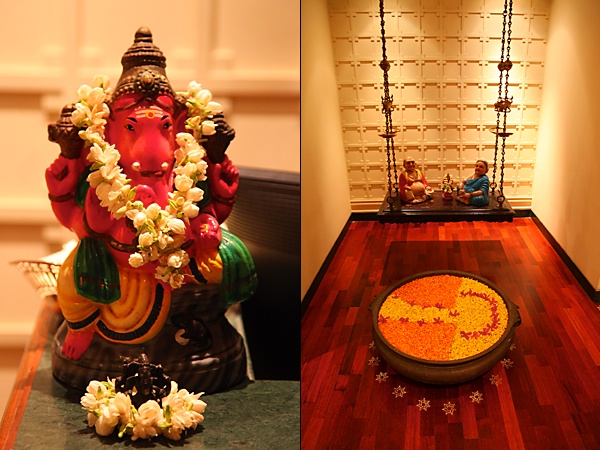
 Recipes from Dakshin ITC, courtsey chef Manu
ALVEMANDE PODI
A spicy hot and savoury dish from the Sarawat Brahmin community in Karnataka. The trick to getting this right is to deep fry slowly on a very low flame, says chef Manu
Ingredients
500 gm (5 cups) colocassia (arbi)
50gms (1/4 cup) tamarind
salt – to taste
1 tsp turmeric
400 gm (4 cups) fine semolina or rava
1 tsp red chilly powder
oil – for frying
 Method
1)Â Â Â Wash the arbi, peel it and allow it to boil with salt, tamarind and turmeric powder.
2)Â Â Â Allow it to cool.
3)Â Â Â Marinate the boiled arbi with salt, lemon juice, red chilly paste.
4)Â Â Â Coat it with rawa (semolina) and press firmly to ensure that rawa is evenly coated.
5) Â Â Heat oil, add the semolina coated arbi and fry till well cooked and golden brown in
color.
6)Â Â Â Toss again with gun powder or red chilly powder, toss and serve crispy hot.
Serves 4
 KORIVIKARAM CHUTNEY
A spicy chutney from Andhra. Try using salem chilies if you can lay your hands on some.
Ingredients
1 Kg (10 cups) Salem Chilies
500 gm (5 cups) Salt
500 gm (5 cups) Tamarind – 500gms (5 cups)
3 tbsp Ghee
50 gm (1/2 cup) red chilies
100 gm (1/2 cup) mustard
3 sprigs curry leaves
50 gm (1/2 cup) asafetida or hing
Method:
1)Â Â Â Soak tamarind pulp, red chilies (without the stem) and salt for 10-15 mins.
2)Â Â Â Grind the above mixture into a very coarse mix.
3)Â Â Â Place the mixture in a pickle jar/ bharani and allow it to rest for 3-4 days.
4)Â Â Â After 3-4 days, make a fine paste of the chilly
5)Â Â Â Heat oil add mustard, curry leaf, red chilies and hing and allow it to crackle.
6)Â Â Â Add the tempering into the paste and serve with steamed rice/ dosais.
OLAN
This dish originating in Kerala, is one of the 18 compulsory dishes to be served during a traditional sadhya mealÂ
Ingredients:
150 gm (1/2 cup) black eyed beans or cow peas (van payaru)
300 gm (2 cups) white gourd (elavan), chopped into thin slices of about 3 cm by 3 cm
100 gm yellow pumpkin (mathan) (optional), chopped into thin slices of about 3 cm by 3cm
50 gm or about 5 chillies (slit)
400 gm (2 1/2 cups) coconut, grated
curry leaves, a few
80 gm (1/2 cup) oil
salt to taste
 Method:
1)Lightly roast the beans and soak it in water for 8 hrs. Wash & strain well.
2) Extract thick milk and thin milk from the grated coconut.
3)In a pressure pan, add beans, both vegetables, chilies and thin coconut milk.
4) Pressure cook up to 1 whistle.
5) After opening the lid, add salt and thick Coconut milk
6) Simmer, ensurer that the coconut milk does not curdle
7) Add coconut oil and curry leaves. Serve hot with steam rice.
Serves 4Â
TINDLI BIBO UPKARI
This dish originating from the saraswat brahmin community of Karnataka is made with tindli or tendli or ring gourds is a great side dish in a meal
Ingredients:
300 gm (3 cups) ring gourd or tendli
200 gm (2 cups) cashews
3 tbsp oil
1 tsp mustard
2 to3 dry red chillies
1 sprig curry leaves
1/2 tsp asafetida
50 gm (1/2 Cup) grated coconut
Method:
1.Soak cashewnuts in warm water with little salt.
2.Cut the tindli into quarters; ensure that they are green and not red from inside.
3.Blanch the tindli and keep aside.
4.In a kadai, heat oil, add tempering and red chillies and allow to crackle.
5.Add curry leaf and asafetida and cook for a while.
6.Add the soaked cashewnuts and tindli and toss.
7.Add grated coconut and salt and mix.
Serve hot with steam rice and sambar.
Serves 4Â
TARKARI PADARTHA
A mixed vegetable dish from Mangalore, great as an accompaniment to rice or chapatis.
Ingredients:
100 gm (1 cup) carrots
100 gm (1 cup) beans
100 gm (1 cup) peas
100 gm (1 cup) cauliflower
100 gm (1 cup) baby potatoes
salt to taste
400 gm (4 cup) tomato puree
400 gm (4 cup) cashew paste
2 tsp red chili powder or to taste
3 tbs ghee or oil
1 tsp mustard seeds
2 to 3 green chillies
2 sprigs curry leaves
3 tbs coriander powder
1 tsp red chilly powder
1/2 tsp turmeric powder
 Method:
1. Cut the vegetables into desired shapes (preferably small dices/ medallions)
2. Heat oil in a handi, add mustard, red chillies and curry leaf.
3. Once it starts to crackle, add the tomato puree and cashewnut paste.
4. Add some water, mix well and allow the gravy to cook.
5. Add the masala powders and allow to cook till the gravy starts to leave oil on the sides.
6. Once the gravy starts leaving water, add the cut vegetables.
7. Mix well and cook till the vegetables are well cooked.
8. Heat ghee in a pan, add the green chillies and fry it till golden brown.
9. Add the oil and green chillies on top of the gravy and keep it covered.
10.Remove from heat and serve hot with Veechu parathas or appams.
Serves 6
PARRIPU KOOTAN
Served during a traditional sadhya, this festive dal is a great variation to the simple dal and adds zing to a meal.
 Ingredients:
450gms moong dal
Salt to taste
2 tbsp ghee
5 to 6 red chilies
2 tsp mustard
curry leaves
400 gm grated coconut
1 tsp cumin
5 to 6 green chilies
 Method:
1.  Boil the moong dal with turmeric and curry leaf, till well cooked and mushy
2. Â Â Grind grated coconut, cumin and green chilies into a fine paste.
3. Â Â Add the ground coconut paste into the dal and mix well and allow to simmer.
4. Â Â Heat ghee, add mustard red chilies and curry leaves. Once it begins to splatter, add the tadka into the dal.
5. Â Â Cover the gravy for 5-10 mins and serve hot with steamed rice.
 Serves 4
MANGO DRY FRUIT PAYASAM
A specialty dessert from the temples of Tanjavur, Tamil Nadu. The dish ismade during the summer seasons using tropical fruits such as mangoes (or
even jack fruit).
Ingredients:
250 Gms (2 cups) mango puree
80gms (3/4th cup) sugar
1 tsp cardamom powder
500ml (2 cups) milk
2 tsp rice flour
100 gm(1 cup) assorted nuts (pistachios, almonds, cashews, raisins)
     Method:
1. Boil milk in a handi, add sugar, cardamom powder and rice flour to it and allow the milk to thicken and reduce.
2. Allow the mixture to cool.
3. Boil the above nuts and cut into fine pieces.
4. Add the nuts into the reduced milk.
5. Make mango pulp/ puree and mix the mango pulp into the reduced milk.
6. Â Allow the payasam to cool, serve in small bowls garnished with
chopped nut and raisins.
Serves 4
To receive recipes, tips and inspiration that feeds your body, mind and soul subscribe to Divine Taste newsletter
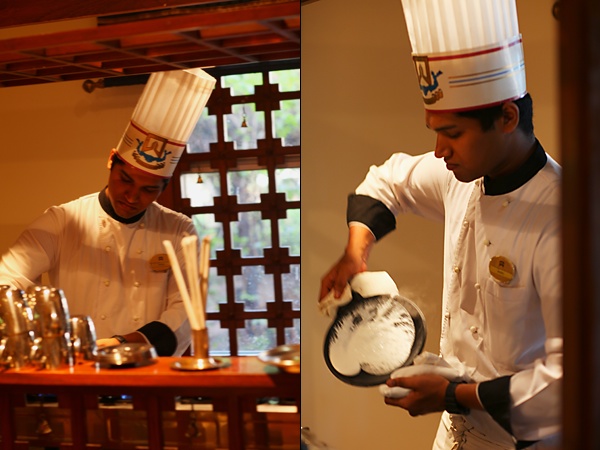
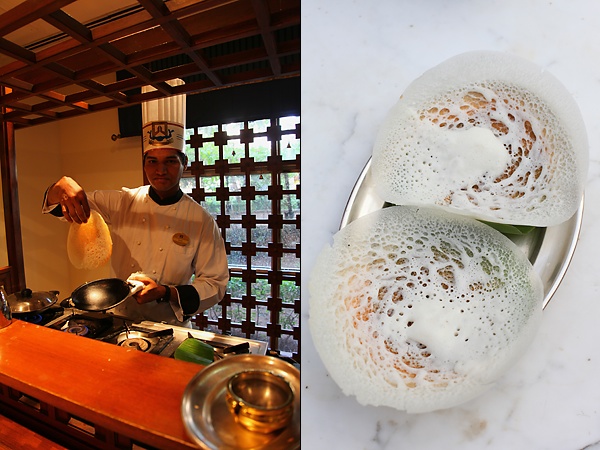
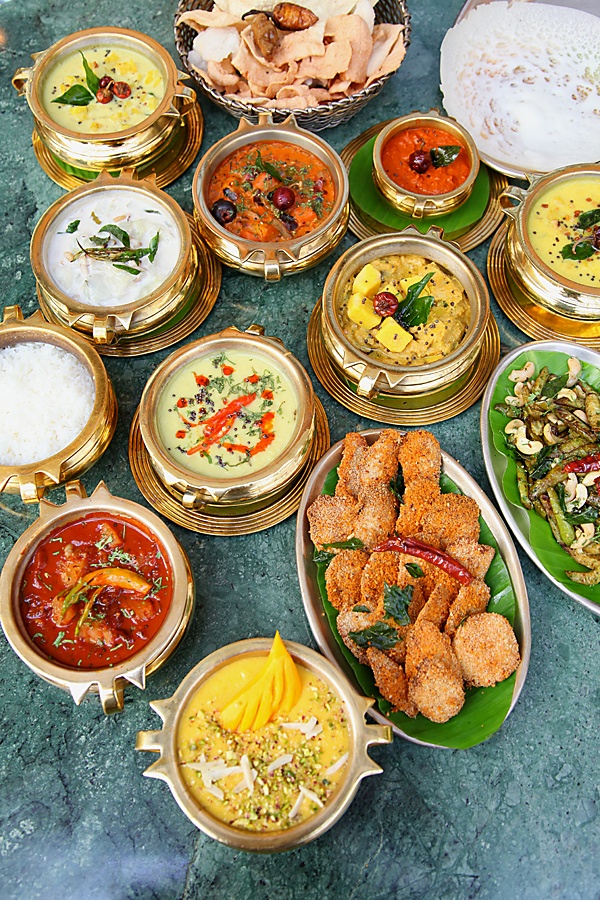
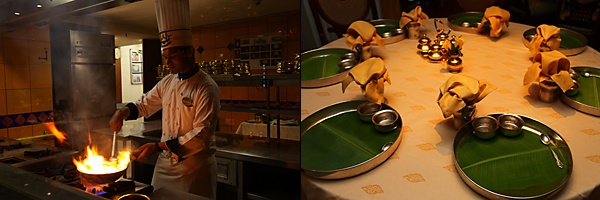
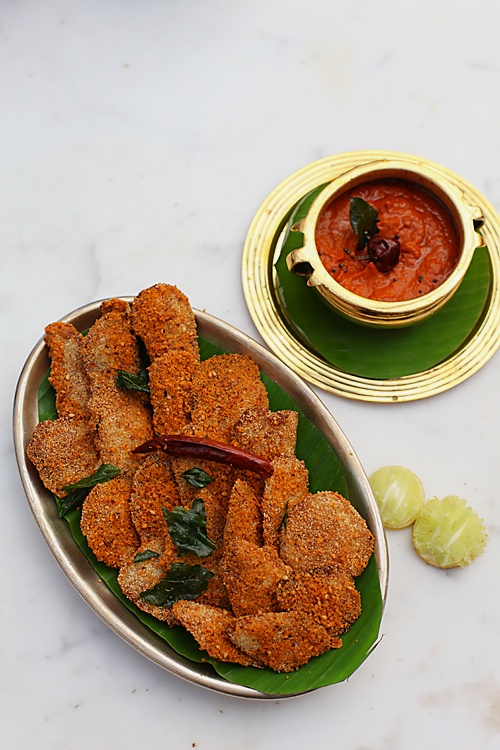
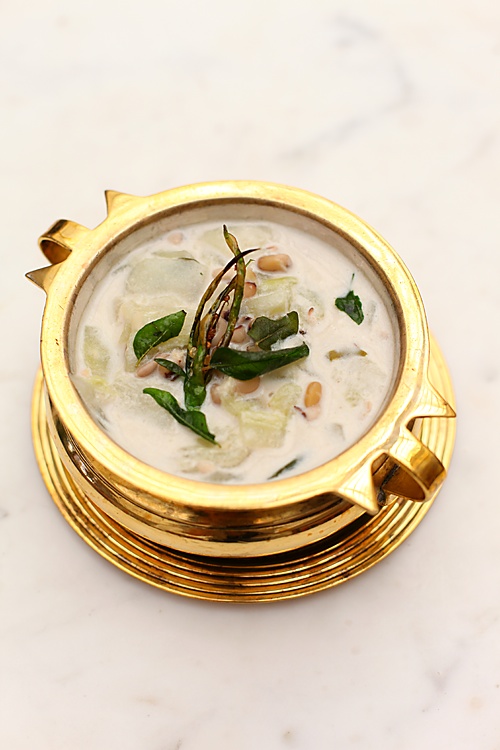
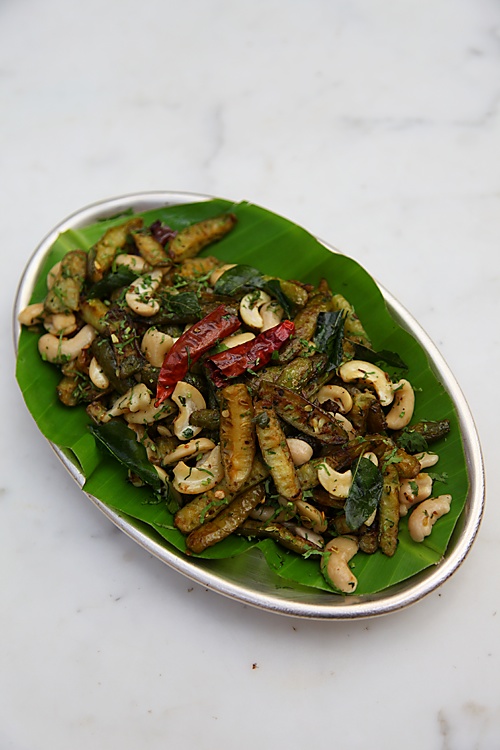
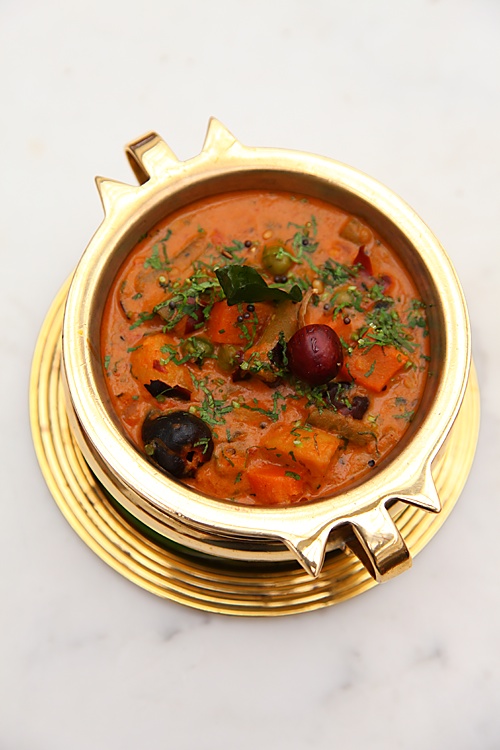
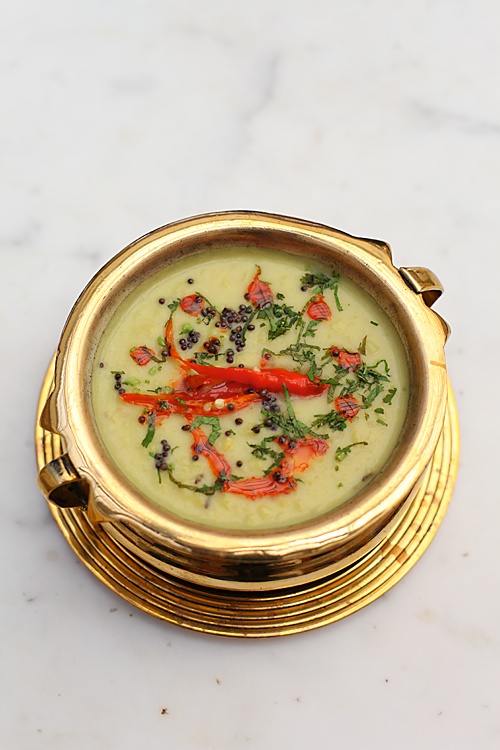


Thankyou! Been a huge fan of your website for long..and today cudn't stop myself from writing a comment. You do a wonderful job with your blog! Your food pics are a treat to eyes, makes me hungry every time i look at them 😉
Hope you will continue with restaurant reviews like this one..
Wow! This is a fantastic post. Thanks so much! I have also been following your blog for a long time now (your droolworthy photographs in particular make it hard not to!). What a treat to have these recipes from Dakshin's kitchen. Thank you for sharing.
Simi
Lovely post with great clicks. Have been trying a lot of your recipes with great success. Thank you.
Hi
I have been following your blog for a while now, and this post of yours has forced me to comment because it is so nice of you to share such authentic recipes from dakshin with your lovely post as always…Love your blog which is so amicable, your pics and of course your recipes.. even we eat no onion and no garlic food.. And yes yummy recipes have been there for generations without onion and garlic.. Thank you for sharing
What a delicious spread!!The alvamande phodi and tendli bibbe upkari which is regular Konkani fare looks so spectacular.Thanks for such a wonderful visual treat!
Beautiful post… Love all the photos. Everything looks mouthwatering!
Shimsha, Simi, Vidya: Great to hear from you guys! Hope to hear more often from you.
Poornima: Nice to know that you have been trying my recipes with success. Thank you for your feedback.
Divya & Chinmayie: Glad you'l liked it!
hey.. Awesome post.. I absolutely love Dakshin too.. have been there many times and absolutely love the eggplant curry and appams!!
This is such an awesome post!!! I loved all the recipes especially the one of Tarkari Padharta. I will be trying that very soon 🙂
Hi, Anushruti; a lovely post, but I'm learning that with Divine Taste that's only par for the course!:) I was wondering if you could enlighten me as to why onions and garlic are not considered sattvik. As far as I know, both have several health benefits, with no side effects either. I've tried to find out on earlier occasions as well, but I couldn't find anything scientific. I was hoping you could help me out:) Thanks!
Such a nice spread and an awesome post..nice recipes and would love 2 give a try…can u share d recipe of manga curry too??
Such a visual treat!!! And yes..being a Keralite, needless to say I loved the spread.. and so good to see the face behind getting mentioned. Usually restaurant reviews are about the spread and very rarely about these talented people..
And u pointed one thing right..in many places abroad, Indian food is so synonymous to the ones with onion n garlic that many people are not aware that there exists dishes which do not use these..and for those readers, this will be a great to know fact..Keep rocking!
Hi,
Been a silent reader so far..love the calmness in your blog. Thanks for such a beautiful post on sattvik food.. look forward to more.
WOW!!… is all I can say after reading this post and glancing through the pics!
I am lucky to read this post and get my hand on recipes of such rare, exotic, traditional cuisines from south India! Thanks a lot for this post Anu!
Now, I should debate and decide what dish to try first, among the drool-worthy ones you have shared here! 🙂
Great pictures and the food looks mouth watering….. Looking forward to visit dakshin soon….
Wow Anushruti, if I was a chef, I couldn't have asked for a better reviewer or review. The effort you have put in (and of course Mr.Manu Nair and the staff too) is breathtaking. Such a delicious spread, such beautiful photos, so much of information and of course, the recipes. Absolutely fantastic. Makes me want to visit ITC Maratha asap and I will, as soon as I possibly can. Thank you so much, this post is truly delightful in every way.
Wow loved the post and wondering how do you manage to cover such fine details, let it be recipe/picture….You keep us inspired with your lovely posts…
Such a delightful post!! I am so hungry now!! 🙂 But I am feeling happy, I am relocating to India (yay!!) next week and all I can think of is gorgeous food all around me, hehe!! This post of yours is particularly bookmarked, I HAVE to try all these recipes, some of them are already my favorites and some of them I have never hear of. Thanks for sharing!!
Dear Anu,
your blog is a feast to the eyes and soul. a beautiful post. i loved that squeezed out lemon halves next to arbi fry. a fabulous spread, very well written… thanks for sharing!
I've been reading your blog for a while now and this is my first comment. Love the pictures and description in all your posts. I like that you minimize the use of onion/garlic/eggs, which suits a south indian like me just fine (I'm a Kannadiga from Bangalore). This post was excellent. I am so inspired to cook these dishes, especially given that they're straight from the horse's mouth so to speak…the chefs at ITC do such a wonderful job always.
Thanks and keep up the good work!
Shubha
Wow!! love the post, love the description, the pictures and everything about it!!
Cheers
great food
Wow!!!! GR8 Job Anu!!!!!! this is going to keep us busy for the whole month we used to wait for every single recipe on your site…..now we have it ….Kitni recipes chahiye lelo…..:)sooooo many at a time? But Thanks!!!! awesome recipes ,shall definately give a try…..feeling extremely exhausted reading this …..Abhi we have to pull up our socks and get ready……1 by 1 try them….or else thinking of booking a table on the given nos…..God ! am so confused…..what a visual treat this is….GR8 GR8 SIMPLY GR8
3 CHEERS!!!! TO ANU AND MANU!!!!!!
Hope we don't become like that seth and sethani…..sitting on that swing after eating soo many things(jus jokin)….never mind we can always work out on extra hours in yoga…or else hit the gym….but no compromise on eating…..right! am gonna try all this….
Chef Manu you are true perfectionist. Beautiful pictures. See you at Dakshin ITC Maratha as always. 🙂
Came to your blog via Kamini's blog. Beautifully written and also great pictures. Enjoyed the whole writeup and hope to enjoy the lovely recipes you shared. Thank you for sharing the recipes.
Wonderful post and even more wonderful are the receipes so well written!
I am a believer of 'You are what you eat' so sattvic food ranks high on our dining table. I'm raising my daughter who's almost two and a half with sattvic food!
Can't tell you how happy I'm to see so many sattvic receipes in one go!
Enjoying your blog!
Thanks,
Manjari
Thank you everybody for your comments and feedback!
Vatsala: Onions and garlic are supposed to be rajasic and tamasic in nature and therefore not used to cook sattvik preparations. They are known to have several health benefits, no doubt but their side effects are also proven in some studies. You might like to look at these links http://www.relfe.com/health_benefits_of_garlic.html and http://www.raw-food-health.net/Onion-Toxicity.html
Apart from our vedic texts which forbid the use of onions and garlic in food preparations for offering to the gods other eastern philosophers also forbid the use. Tsang-Tsze described the Alliums as the “five fragrant or spicy scented vegetablesâ€â€”that each have a detrimental effect on one of the following five organs—liver, spleen, lungs, kidneys, and heart. Here's an interesting read
https://www.facebook.com/note.php?note_id=126625080704050
pratibha: Its a simply gravy..cook mangoes with turmeric, salt and water. Make a paste of coconut, green chili and cumin. Add this paste to the simmering water. Stir in some yogurt and cook on low heat. Give seasoning mustard, fenugreek, curry leaves and dry red chili.
vidya: That's a very important point. Thanks for sharing.
Aditi: Love listening from silent readers like you. Thanks for breaking the silence. 🙂
Ashwini: Hope you are doing well..when I don't hear from regular commenters like you for a long time, I wonder if all is well with you. Great to hear from you!
Poornima: Thank you for your kind words. You are a sweetheart!
Deepa: Thanks for noticing the minute details and the efforts that I put in behind every post.
Ambika: Great that you are moving back! Look forward to great posts from you!
Shubha: I don't minimize the use of onions, garlic and eggs! I dont use them at all! 😉
Manjari: Nice to know that you are raising your daughter on sattvik food. It will do her body, mind and intellect a great deal of good and you will reap the benefits as you watch her grow. All the best to you!
I checked out the links you posted. Thanks so much…It was a very informative read! I am always trying to cook and eat food which is good for my body and mind, and this was a real eye opener!
wow… a fantastic post. the pics.. the recipes everything. thanks for sharing.. would surely try some of the recipes, especially the colocasia fries.
What a delectable spread! Great pictures and this space is getting better and bigger with each post and endeavor 🙂
What a delectable spread! Great pictures and this space is getting better and bigger with each post and endeavor 🙂
Hi!
Have been following your blog for a while….the pictures you post are fantastic and the same goes for your recipes as well.I am always looking out for new food to try, will surely try some of these.I love the Colocassia fries…made it for the kids and they wiped it off clean…of course with lesser chillies. Well…just an input…I do the same with aubergines as well and the crisps turn out great.Looking forward to more.Also would appreciate if you looked up my blog (a very juvenile one for now) and send in feedback too.Tks
hi anu…
wow that was a fantastic post…i live in the US and reading your posts is like coming home…i can almost taste that olan …like my mom used to make…anyways ur food seems so clean and pure and classic…keep up the goodwork…
deepa…
Lovely coverage of the meal at Dakshin. Its been a favourite of mine for as long as I was in Bangalore. Great pictures as usual too!
Such a lovely write-up. I'm going to try the arbi fry pronto. Thanks for sharing.
Hi Anu, wonderful post. Great info about onion and garlic. Could you please clarify the recipe for tarkari padartha, is the qty for tomato paste and cashew paste actually 4 cups each? It seemed like it might be be a bit much. Thanks for the recipes.
Beautiful presentation of Dakshin sattvik south indian menu, one of the best from rest internet reviews.
Note: I agree with comment 38 about quantity of cashewnut paste. 4 cup paste is out of proportion for sattvic style cooking. Cashews are very hot in property so need to be delicately used.What kind of dry round red chilies are used for end tempering? Please re-read recipe, it sure needs some corrections.When recipes are given by top five star chefs, people will blindly follow without reasoning, they should have rechecked recipes before passing.
Thanks.
Hi!
I just adore your blog, so many interesting recipes and the pictures of the food are really so divine!
I hope that you post many vegan recipes in future. I hope you post vegan recipes of kheers and halwas. I know it is hard to be a vegan in India, but I feel you can come up with innovative and creative vegan recipes…
Years ago I was so surprised to find that milk and milk products cause pain and suffering cows. Cows are forced to produce more milk. Cows are repeatedly pregnated so that they keep on
producing milk, and the lifespan of the cows has decreased now…
I often read blogs such as vaishali's holy cow, vegan dad, fat free vegan and India vegan for tips , ideas and recipes.
Thanks again for posting many vegan recipes, which is good not only good for our health, but also for our environment.
Global vegan fare
In short, the condition of cows is really very sad. I really wonder what lord Krishna is feeling after
seeing the suffering of cows in India and across the world…
Thanks for all the feedback folks!
Vidya: The ratio of tomatoes and cashews are equal in proportion in the recipe. For home cooking you can reduce the cashews and use 1/2 a cup or skip it altogether and use more tomatoes and a little sugar to cut the sourness of the tomatoes in the gravy.
Sattvik: When cashews are soaked and blended and cooked they become less heating to the body and the amount of cashews going inside a body would be just a few tablespoons. And cashews are used as a substitute to onions in the recipe here and cashews are anyday an acceptable substitute to onions in sattvik cooking. I agree that the quantity of cashews used in the recipe for homestyle cooking maybe a little too much so you can reduce or omit them altogether. With over 75,000 pageviews a month, I have a certain duty towards my readers and a lot of efforts go into what is published here. And I would not publish anything here without checking it.
Kumudha: Thanks for your comment and concern. Many of the recipes here are naturally vegan. I like to stick to traditional vedic style of cooking and many of them use dairy as a lot of emphasis is given to milk and milk products in ancient cooking. I totally agree with you that cows are in a bad state and they are not treated as they should be or as they were in olden days where they were well tended to, happy and produced enough milk for the calves and for the families who kept them. That is why I try to buy milk from dairies where I know they are treated fairly well!
This looks like a dream feast. Utterly amazing. Love the dishes too!
Hey Anu! Thanks for the concern. I am good.. 🙂 Have been slightly busy with travels going on.. I made ALVEMANDE PODI and PARRIPU KOOTAN last night and they came out superbly delicious! It was enjoyed by all. I was especially happy to serve that to my mother who is a great cook herself and who has been serving me with her delicacies all these days.. Hope to get more recipes of such rare, traditional dishes from your space!
Just came across your blog today, and it is LOVELY. Amazing pictures and great writeups. I love the idea of satvik food that is so tasty and not at all about deprivation from taste. This post is so great to showcase tasty home cooking that is different from the stereotype heavy, oily, spicy restaurant food. One question: WHERE to source those beautiful little urulis for serving? Are they really food safe? Thanks!
Another question: someone upthread rightly pointed out the miserable treatment of dairy animals, and you agreed and said you only purchased from reputable dairies which treat their animals well.
Can you please share which these dairy farms are, and how you have determined they do not illtreat the animals?
I am sure many people would appreciate the information, and if this awareness spreads, then other operations will also follow suit. Thanks in advance!
Its very nice information. Indian delicacies have maintained their traditional cooking techniques and spices. When making a choice of the restaurant to have the authentic Indian cuisines one should be well informed of the different Indian main meals and desserts.
Ashwini: Glad you enjoyed the alvemandi podi and kootan.
S: Thanks for your feedback. Those urulis are used for serving food and not cooking in it. They are plated from inside and are food safe ofcourse! Try looking for them in stores down south. In India, it is a little difficult to determine the authenticity of dairies but there are a few people who are making efforts in this direction. http://www.govindmilk.com/index.html
very good dishes without onion&without garlic
I read this article fully concerning the comparison of latest
and earlier technologies, it's awesome article.
Have you ever thought about including a little bit more than
just your articles? I mean, what you say is valuable and all.
Nevertheless think about if you added some great pictures or videos to give
your posts more, "pop"! Your content is excellent but
with pics and clips, this site could certainly be one of the most beneficial in its niche.
Terrific blog!
craving to have home made food. rich culture ,food fit to be offered as naivedya . legacy continued uninterrupted
Hi,
I enjoy going through your website, more so because it is one of the few which give recipes which are not just vegetarian, but also omit onion and garlic. Though I am not completely averse to it, at home, the food we prepare usually does not have onions and garlic (most gujarati brahmins, vaishnav and jain families do not have onion and garlic). Most of my friends are unable to comprehend how anyone can prepare majority of foods without adding the two. Guess it is similar to our western friends who are surprised with the extent of vegetarianism in India.
Thankuuuuuuuuuuuuuuuuuuuuuuuuu…that's all I can say. Its been a pleasure reading this delicious looking post about "Satvik" recipes (and I promise I'll try my best to make all of these). Already tried one today of mango payasam ^.^ with a twist of using a thick mango (& certain other fruits) mixed fruit juice in the payasam, but the flavor is awesome. My husband loved this new recipe and I'm gonna try it again & again. I will be recommending this recipe for sure to others as well.
Happy Friday!!!
Thanks for your interest Shweta. Look forward to hearing more from you.
What's up, after reading this amazing paragraph i am also happy to share my familiarity here with colleagues.
one of the best fooding site
Such a lovey post Anushruthi.I have been pondering over and over your blog lately.I am blown over by your pictures 🙂
Just awesome !!!
I'm not going to lie, it was a pretty long process (about 2 months) to
hammer out the details, but I was able to pull it off with a
few bumps and bruises. You will want to consider the style of your
doors to find out which companies carry them. It may appear stupid to
own a machine that only shapes metal into
one form.
Here is my web-site :: liftmaster (Doyle)
Generally, steel doors are more inexpensive than wooden doors.
The handle that you select for the door and the insulation will
all also contribute to the overall cost. It may appear stupid
to own a machine that only shapes metal into one form.
Also visit my site: small garage doors for sheds (Mozelle)
hey lukin forward for more dishes.
Hey! Really awesome to read the reviews and recipes. I am from Chennai and it is really difficult( read impossible) to buy satvik food. So since very recently we moved on to saathvik lifestyle, I am exploring the various options. Thank you so much. Good job. Keep going.
Thumbs up!!
Abinayah: I know how difficult it can be down south to get sattvik food options. Hope you find options to cater to your needs in this space of mine.
Hi,
You have such a wonderful blog and i try many recipeswhich is a great hit with my family.
Though i am an orthodox tamil brahmin, i stick to the usual sambar-rasam (sans onion-garlc), everyday and occasionally i do try pulaosor sabzis adding onions and ginger garlic.
Onion and garlic cannot be said they are unsuitable cos after both my pregnancies my folks gave garlic daily to increase my milk supply. I ate garlic for almost an year and found it very beneficial.
My grandad was asked to eat raw garlic daily to bring down his high sugar levels.
Pls enlighten…
Thanks
Mini
Mini: I'm glad you asked this question. Onions and garlic do have some health properties, there is no disputing that. The Bhagavad Gita classifies food into Sattvik (mode of goodness), rajasik (mode of passion) and tamsik (mode of ignorance) categories. And onions and garlic fall into the tamasik category. And if one is interested in pursuing a holistic way of life based on ancient vedic scriptures, it is better to avoid onions and garlic.
Compliments to Chef Manu, who shared his recipes with us. I love south Indian cuisine. As if I make some south Indian dishes at home but you gave me some new ideas. Thanks for sharing such recipes.
Out of all dishes I like ALVEMANDE PODI.It;s recipe seems to be easy.Thanks for sharing delicious south Indian recipes.
hello from germany
dear anushruti, please accept my countless appreaciations and thanks for your great work.
i would like to try TARKARI PADARTHA. how can i make cashew paste, could you give me the measurements…
thanks a lot,
selma- Soak cashew nuts in water for 30 minutes and blend into a smooth paste using a little water. Hope this helps.
My friend recommended your blog to me as being a vegetarian, I keep on looking for eggless options. I had liked it and made your mango mousse a few times, which was a great hit in our home.
This particular post is awesome. You have pictured the dishes so beautifully. Thank you for a wonderful article.
I will be trying all the recipes given here.
Sandhya- Good to know this. Do try the recipes and give me the feedback.
Thanks for the detailed recipes and varieties.
My pleasure!
I am in love with south indian meal and dishes.
Thanks so much for sharing this detailed post. Just loved it.
You are welcome. Glad you liked it.
Loved the whole meal concept. I am going to try the recipes you've mentioned. Already very excited.
Hi
You have very good recipes. Request you to provide an option to search for a recipe. I could not find this facility or might be it is not intutive enough for me to figure it out.
Thanks.
Hope a few words of mine won't spoil… "Sattvik way of cooking is not just throwing out the onions or garlic… It means a lot.. Conscious -clean-pure-essential-vital-seasonal the sattva Gunas….And obviously, for a King I won't recommend a sattvik diet.. Because we don't want our king to be a Yogi… As a ruler he needs the "other Gunas also… Its all about balancing.. Satvik is not for everyone..Appreciations for bringing up this topic.. and some of the recipes above needs a balancing..Cashews are good for health, but 400gms of cashew paste in a curry definitely make your stomach bloated..takes much more time for digestion..
Thank you.
Check Wonderful Benefits of Cow Ghee: https://daisyorgamixstore.blogspot.com/2023/01/best-quality-cow-ghee-best-organic-shop.html
Thank you for your message. The bhagavad gita recommends a sattvic diet for everyone. A sattvic diet gives clarity and makes one energetic and although it is meant for people following the yogic path, anyone can benefit from it. I agree cashews are rich, but this is to be taken in moderation, once in a way and one portion is for many to enjoy, not just an individual.
The recipe index is right on top of the website. You need to click the recipe index on top right and then you can either search any recipe or click the recipe index box for a drop down menu with all the recipes by category.